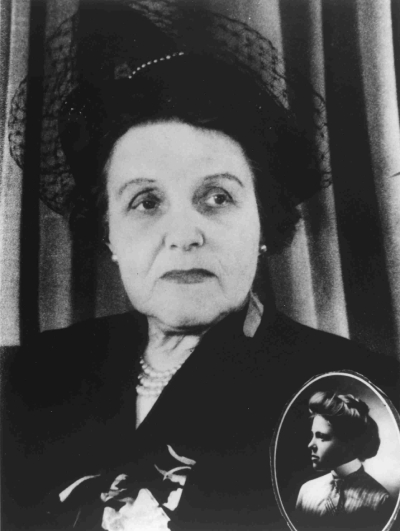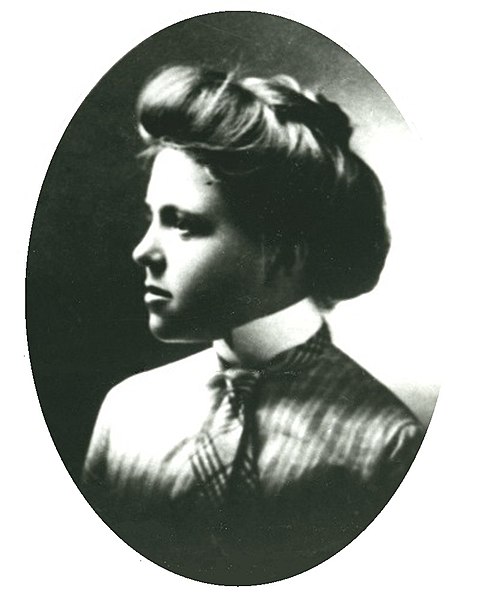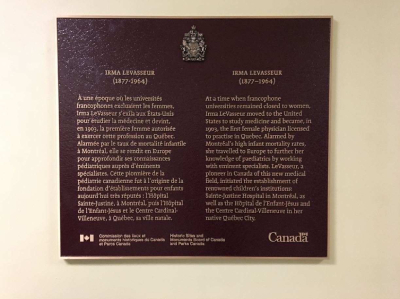Dr. Irma LeVasseur National Historic Person (1877-1964)

© Bibliothèque et Archives nationales du Québec / P655,S2,SS6,D8,P1
Dr. Irma LeVasseur was designated a national historic person in 2008.
Historical importance: One of the pioneers of paediatrics in Canada, co-founder of two hospitals for children.
Commemorative plaque: 1401 18th Street, Quebec Footnote1
At a time when francophone universities remained closed to women, Irma LeVasseur moved to the United States to study medicine and became, in 1903, the first female physician licensed to practise in Quebec. Alarmed by Montréal's high infant mortality rates, she travelled to Europe to further her knowledge of paediatrics by working with eminent specialists. LeVasseur, a pioneer in Canada of this new medical field, initiated the establishment of renowned children's institutions: Sainte-Justine Hospital in Montréal, as well as the Hôpital de l'Enfant-Jésus and the Centre Cardinal-Villeneuve in her native Québec City.
Dr. Irma LeVasseur
At a time when the doors of Francophone universities were still closed to women, Irma LeVasseur was one of the female pioneers who managed to receive a degree in medicine and practice in a profession that was occupied almost exclusively by men. Considered one of the pioneers of paediatrics in Canada, she was one of the few women to practice this new medical specialty at the turn of the 20th century, thanks to her knowledge of the latest advances in this field drawn from significant international connections, notably in the United States. She was the instigator and co-founder of two hospitals for children that are now internationally recognized and was responsible for founding a centre for the rehabilitation of disabled children in Québec City.

© Bibliothèque et Archives nationales du Québec / P655,S2,SS6,D8 / Public domain image
Irma LeVasseur was born in Québec City to a family of artists; her mother was an opera singer and her father, a multi-talented journalist. She was not sheltered from hardship, however; her younger brother died in 1881, her mother left the family in 1887, and her older brother had a mild disability that prevented him from attending regular school. Affected by all of this misfortune, she decided to become a doctor at a young age in order to treat people with illness or disabilities. At the age of 17, after achieving great success in her studies in Québec City, she moved to the United States to study medicine. At the time, women were not admitted to faculties of medicine in Canada's Francophone universities. Upon returning to Canada with her diploma and two years of residency under a highly regarded U.S. paediatrician couple, she faced yet another challenge. She needed to petition the Legislative Assembly for the right to practice medicine in Quebec. She then settled in Montréal where she worked at the Crèche de la Miséricorde. Dismayed with the high mortality rate among children in urban areas and by their myriad health problems, she travelled to Europe where she stayed from 1905 to 1907 to further her training in paediatrics, a new discipline in the early 1900s.

Dr. LeVasseur was 30 years old when she returned to Canada in 1907, trained as a paediatrician with leading-edge knowledge in the field in both North America and Europe. Upon returning to Montréal, she started planning for a Francophone hospital for sick children. She described her plans to a group of socially-engaged women, including Justine Lacoste-Beaubien who took charge of the project. In November 1907, the Refuge des petits malades opened its doors. It later became Hôpital Sainte-Justine, today an institution of world-wide renown. The following year, Irma LeVasseur left Canada once again for New York City, and then travelled on to Serbia in 1915, where she volunteered during the war. She returned to Quebec in 1919 and settled in her hometown, still concerned with children's health. In 1923, she opened a health clinic for children in her home, which was the origin of the Hôpital de l'Enfant-Jésus, another world-renowned institution. She also fostered a dream of creating an institution for the rehabilitation of children with disabilities in Québec City, but that dream would not become a reality before 1935.
Irma LeVasseur practiced her profession for more than 50 years, yet she died quietly, forgotten by all, even though she had worked her entire life for the well-being of sick children and children with disabilities and fought valiantly for women's right to practice medicine.
Backgrounder last update: 2017-02-15
The National Program of Historical Commemoration relies on the participation of Canadians in the identification of places, events and persons of national historic significance. Any member of the public can nominate a topic for consideration by the Historic Sites and Monuments Board of Canada.
- Date modified :